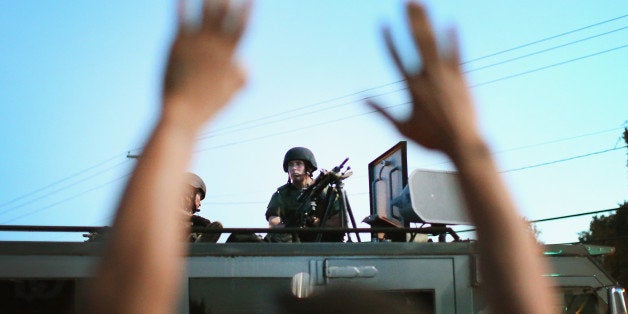
Images of police in riot gear standing atop armored tanks in the streets of Ferguson, Mo. dominated the summer of 2014. That same summer ushered in waves of protesters chanting "black lives matter" -- protests that continue today following the deaths of black men during encounters with the police in Staten Island, Cleveland, Baltimore, and cities across the country.
In response, President Barack Obama created the Task Force on 21st Century Policing. Its mission was to identify best policing practices to change current trends. While the Task Force's final report, released this week, does include some smart recommendations that could improve the criminal justice system, they missed two key opportunities to reform police practices.
What the Report Got Right
The report encourages police departments to use proven methodologies to improve how they interact with communities. For example, it encourages police departments to use community surveys to assess how citizens view the police.
The Task Force also discourages the use of quotas, which help increase unnecessary arrests and incarceration and lead to racial bias. The Justice Department's investigation of Ferguson exposed how the city police department's performance was measured through the amount of revenue it collected through fees and fines charged on defendants. The Task Force also recommends that police departments infuse community policing into their standard way of policing.
These reforms could help avert future "Baltimores" or "Fergusons." But the Task Force falls short when it comes to putting money and muscle behind its ultimate goal of bringing policing into the 21st century.
Where the Recommendations Fell Short
The federal government sends more than $3.8 billion in grants to states and cities for criminal justice purposes each year, mostly for law enforcement. These federal dollars play a pivotal role in driving state and local policing policies as the demand for police funding has grown steadily over the years.
The Task Force should have taken this opportunity to recommend that the Obama administration review and revamp all federal grants supporting law enforcement to better focus on 21st century policing priorities, i.e. tying grant dollars to promoting outcomes that both reduce crime and unnecessary arrests and incarceration. This would give the nation's 18,000 individual law enforcement agencies a monetary incentive to change current police practices.
The report also falls short in its recommendations on police use of new technology. Using cutting-edge technology like drones, cell phone trackers, surveillance cameras, body worn cameras, and more, allows police to gain access to a volume of personal information that was unprecedented even twenty years ago. Today, courts and legislatures (federal, state and local) are scrambling to keep up with these developments, with technology often outpacing the law.
The Task Force correctly recognizes that having access to the technology doesn't necessarily mean police should use it. And the report gives a hat tip to the complex privacy and civil liberties issues accompanying technologies like body worn cameras. But the actual recommendations fail to put muscle behind the rhetoric. One key action item, for instance, directs that any measures addressing technology and privacy be guided by constitutional law - a laudable goal, if an obvious one. But the report provides no guidance on what limits the Constitution imposes when police deploy the technologies in question. And the language accompanying this recommendation emphasizes that law enforcement should have maximum access to information obtained from cell phones, GPS, and more -- technologies that yield sensitive, revealing data.
On the use of specific technologies, the report largely punts, offering superficially encouraging language but little real framework for reform. For instance, almost every day brings a new report on futuristic biometric tracking technologies, from facial recognition to remote iris scanning. If these technologies are deployed against state DMV databases or the motherlode of personal photos, Facebook, they would allow the covert identification of nearly any person from afar, hastening the end of anonymity -- and privacy in public -- as we know it. Stringent controls are needed to ensure that these tools are used to further legitimate law enforcement purposes and are not abused. The report calls for the Department of Justice to develop best practices and toolkits on the use of biometric technologies, but provides no direction as to the content of those policies.
In short, the report takes some important steps forward. But it is incomplete. We urge the president to view the Task Force's report not as an endpoint, but as a springboard to ensure meaningful criminal justice reform and fidelity to constitutional protections.